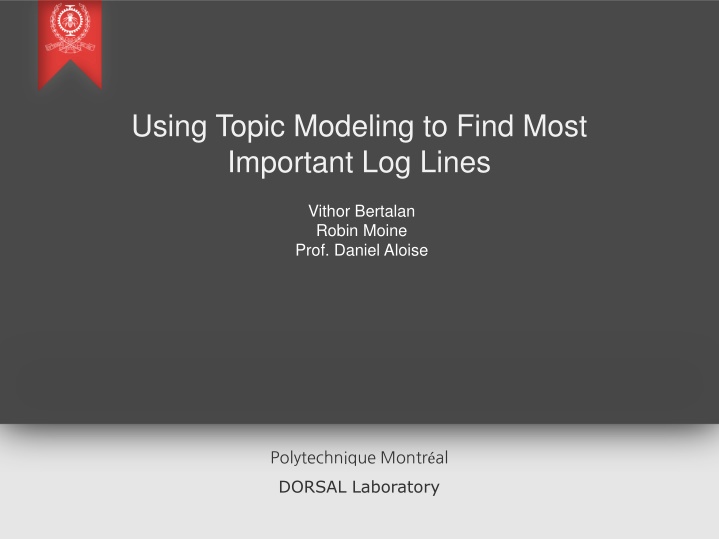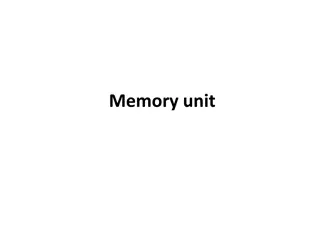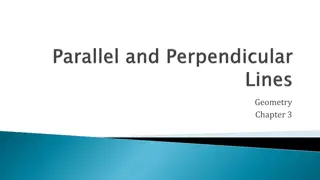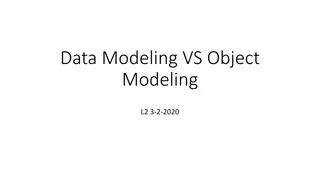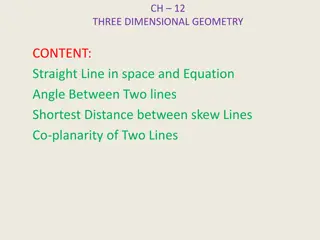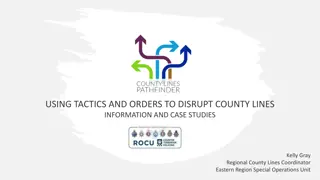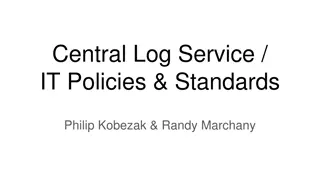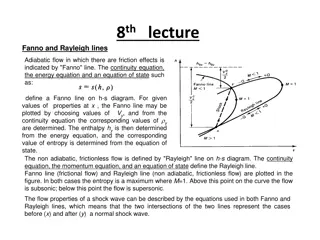Utilizing Topic Modeling for Identifying Critical Log Lines in Research
By employing Topic Modeling, Vithor Bertalan, Robin Moine, and Prof. Daniel Aloise from Polytechnique Montréal's DORSAL Laboratory aim to extract essential log lines from a log parsing research. The process involves building a log parser, identifying important log lines and symptoms, and establishing causality between log lines. Key steps include parsing log lines, converting them into mathematical arrays, creating distance and variable matrices, and applying Jaccard similarity distance. This research focuses on enhancing log analysis for improved understanding and troubleshooting.
Download Presentation

Please find below an Image/Link to download the presentation.
The content on the website is provided AS IS for your information and personal use only. It may not be sold, licensed, or shared on other websites without obtaining consent from the author.If you encounter any issues during the download, it is possible that the publisher has removed the file from their server.
You are allowed to download the files provided on this website for personal or commercial use, subject to the condition that they are used lawfully. All files are the property of their respective owners.
The content on the website is provided AS IS for your information and personal use only. It may not be sold, licensed, or shared on other websites without obtaining consent from the author.
E N D
Presentation Transcript
Using Topic Modeling to Find Most Important Log Lines Vithor Bertalan Robin Moine Prof. Daniel Aloise Polytechnique Montr al DORSAL Laboratory
POLYTECHNIQUE MONTRAL Research Parts First step: Build log parser using the whole text Results published in Second step: Finding import log lines/symptoms Third step: Finding causality between log lines Using Topic Modeling to Find Most Important Log Lines Vithor Bertalan , Robin Moine and Daniel Aloise 2/18 dorsal.polymtl.ca
POLYTECHNIQUE MONTRAL Step 1 First step: Parsing each of the log lines using the method from first step of the research, or Drain [1]. Variables are replaced, but are also stored in a separate table. [1] He, Pinjia, et al. "Drain: An online log parsing approach with fixed depth tree." 2017 IEEE international conference on web services (ICWS). IEEE, 2017. Using Topic Modeling to Find Most Important Log Lines Vithor Bertalan , Robin Moine and Daniel Aloise 3/18 dorsal.polymtl.ca
POLYTECHNIQUE MONTRAL Step 2 First step: Converting raw log lines to mathematical arrays. We did the first tests using Transformers, but decided to migrate to TFIDF. Optional step to use RegEx. Using Topic Modeling to Find Most Important Log Lines Vithor Bertalan , Robin Moine and Daniel Aloise 4/18 dorsal.polymtl.ca
POLYTECHNIQUE MONTRAL Step 3 Creating a distance matrix, using Euclidian distance between the log lines. MinMax normalization [0-1] afterwards. Size n (number of log lines) x n Created to represent the distance between the terms. Using Topic Modeling to Find Most Important Log Lines Vithor Bertalan , Robin Moine and Daniel Aloise 5/18 dorsal.polymtl.ca
POLYTECHNIQUE MONTRAL Step 4 Creating a variable matrix, where each parsed Variable becomes a column inside the matrix. Size n (log lines) x v (number of unique variables). Created to carry the value of the parsed tokens. Using Topic Modeling to Find Most Important Log Lines Vithor Bertalan , Robin Moine and Daniel Aloise 6/18 dorsal.polymtl.ca
POLYTECHNIQUE MONTRAL Step 5 Applying Jaccard similarity distance to the variable matrix. Equal lines will have a value of 1, lines with just one token of difference will have a value of 1 (1/number of tokens), lines completely different will have 0. Using Topic Modeling to Find Most Important Log Lines Vithor Bertalan , Robin Moine and Daniel Aloise 7/18 dorsal.polymtl.ca
POLYTECHNIQUE MONTRAL Step 6 Creating a count matrix, where lines that appear close will have a high value. Size n (number of log lines) x n Created to give value to timeframes inside log files. 1 1 0.75 0.5 0.25 0 2 0.75 1 0.75 0.5 0.25 3 0.5 0.75 1 0.75 0.5 4 0.25 0.5 0.75 1 0.75 5 0 0.25 0.5 0.75 1 1 2 3 4 5 Using Topic Modeling to Find Most Important Log Lines Vithor Bertalan , Robin Moine and Daniel Aloise 8/18 dorsal.polymtl.ca
POLYTECHNIQUE MONTRAL Step 7 Weighting each of the matrices: is multiplied by the distance matrix is multiplied by the variable matrix is multiplied by the count matrix + + = 1, so that values are fixed between [0,1] Using Topic Modeling to Find Most Important Log Lines Vithor Bertalan , Robin Moine and Daniel Aloise 9/18 dorsal.polymtl.ca
POLYTECHNIQUE MONTRAL Step 8 Applying DBSCAN to cluster the resulting matrix. Using Topic Modeling to Find Most Important Log Lines Vithor Bertalan , Robin Moine and Daniel Aloise 10/18 dorsal.polymtl.ca
POLYTECHNIQUE MONTRAL Step 9 Ciena wants the key users to provide feedback on the cluster methods. Therefore, our method needs to receive feedback: getting input from the users on which lines should be group d together (must-link constraints) and which ones should not be grouped together (cannot-link constraints). Using Topic Modeling to Find Most Important Log Lines Vithor Bertalan , Robin Moine and Daniel Aloise 11/18 dorsal.polymtl.ca
POLYTECHNIQUE MONTRAL Step 9 Now working on implementing a VNS (Variable Neighborhood Search) with K-Medoids to consider the cannot-link and must-link constraints. Based on the work of [2]. Current work on comparing found clusters, log templates and variables with the ones provided by Ciena. [2] Randel, R., Aloise, D., Mladenovi , N., Hansen, P. (2019). On the k-Medoids Model for Semi-supervised Clustering. In: Sifaleras, A., Salhi, S., Brimberg, J. (eds) Variable Neighborhood Search. ICVNS 2018. Using Topic Modeling to Find Most Important Log Lines Vithor Bertalan , Robin Moine and Daniel Aloise 12/18 dorsal.polymtl.ca
POLYTECHNIQUE MONTRAL Step 10 Using topic modeling for each of the clusters. Topic modeling has been used succesfully for log files, such as in [3], [4]. State-of-the-art methods use Transformers. So as to make the method faster, so far, we are using LDA. [3] Li, Heng, et al. "Studying software logging using topic models." Empirical Software Engineering 23 (2018): 2655-2694. [4] Napolitano, Davide. Log Analysis: Topic Modeling applications on fine-features data processing system. Diss. Politecnico di Torino, 2022. Using Topic Modeling to Find Most Important Log Lines Vithor Bertalan , Robin Moine and Daniel Aloise 13/18 dorsal.polymtl.ca
POLYTECHNIQUE MONTRAL Step 10 Each cluster will have its most important words, as we are selecting just one topic: Using Topic Modeling to Find Most Important Log Lines Vithor Bertalan , Robin Moine and Daniel Aloise 14/18 dorsal.polymtl.ca
POLYTECHNIQUE MONTRAL Step 10 Ranking all the lines of the cluster, based on the shared tokens with the topic words. The line with the most shared tokens is therefore considered as the most meaningful of the cluster. Using Topic Modeling to Find Most Important Log Lines Vithor Bertalan , Robin Moine and Daniel Aloise 15/18 dorsal.polymtl.ca
POLYTECHNIQUE MONTRAL Step 10 Selecting a cluster: Using Topic Modeling to Find Most Important Log Lines Vithor Bertalan , Robin Moine and Daniel Aloise 16/18 dorsal.polymtl.ca
POLYTECHNIQUE MONTRAL Step 10 Selecting just the first topic using LDA: ['0.032*"directory" + 0.030*"no" + 0.029*"file" + 0.026*"such" + '0.023*"localdisk" + 0.021*"cannot" + 0.021*"error" + 0.020*"or" 0.016*"ome ] + '0.016*"cp" + Finding lines with the highest token similarity: Using Topic Modeling to Find Most Important Log Lines Vithor Bertalan , Robin Moine and Daniel Aloise 17/18 dorsal.polymtl.ca
POLYTECHNIQUE MONTRAL Step 10 This line if therefore chosen as the most significant of the cluster. Current work on the feedback on clustering, and creating metrics to evaluate the method in the field of Log Summarization. Using Topic Modeling to Find Most Important Log Lines Vithor Bertalan , Robin Moine and Daniel Aloise 18/18 dorsal.polymtl.ca
